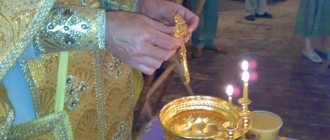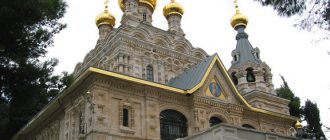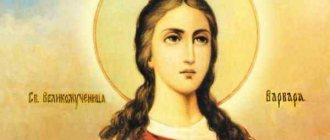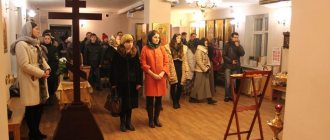The Venerable Martyr Elizabeth, princess of the Russian Imperial Court, abbess of the Martha and Mary Convent, was brutally murdered by revolutionary soldiers. She became famous for her works of mercy, charity and work in hospitals, and among the people she earned the title “Mother”. Nun Varvara, who was Elizabeth's cell attendant, refused to leave her abbess and also accepted martyrdom.
They pray to the Reverend Martyr Elizabeth and nun Varvara:
- about health;
- about assistance during childbirth and pregnancy;
- on promoting the health of premature babies;
- in the treatment of oncology, especially in women's diseases;
- if it is necessary to show humility, endure insults and undeserved cruelty;
- for strengthening in bearing the cross, during suffering, enduring pain and torment.
Prayer
O holy new martyrs of Russia, Grand Duchess Elisaveto and her sister of the cross, the venerable nun Varvaro, who ended her journey in many torments, fulfilled the Gospel commandments with deeds in the Abode of Mercy, laboring for the sake of the Orthodox faith until death in these last times, and good fruit in the patience of the passions of Christ brought it! Pray to Him, as the conqueror of death, that He may establish the Russian Orthodox Church and our Fatherland, redeemed by the blood and suffering of the New Martyrs, and not allow our property to be plundered by the enemy of Russia. Behold, the crafty enemy has armed himself against us, although he will destroy us in internecine battles, sorrows, unbearable sorrows, illnesses, needs and fierce misfortunes. Pray to the Lord to cast down all their feeble insolence; Strengthen faith in the hearts of the Russian people, so that when the hour of testing comes upon us, we will receive the gift of courage through your prayers, having rejected ourselves and taken up our cross, we will follow Christ, crucifying our flesh with passions and lusts. Save us from all evil, sanctify the paths of our life, grant unfeigned repentance, silence and peace to our souls, ask the Lord for all of us to be delivered from bitter ordeals and eternal torment and to be heirs to the Kingdom of Heaven with all the saints who have pleased God from the ages, so that we joyfully give praise , honor and worship of the Father and the Son and the Holy Spirit forever and ever. Amen.
Life
The Holy Martyr Elizabeth Feodorovna was born into the family of the Grand Duke of Hesse-Darmstadt and the daughter of the Queen of England in the ancient historical and cultural center of Germany. The Grand Duchess was considered the best bride in Europe, she was educated and dazzlingly beautiful. Being a true Christian, she was involved in charity work, patronized cultural and artistic figures, and helped those in need.
Elizaveta Fedorovna entered into marriage with the Russian prince Sergei Alexandrovich, although several contenders for her hand and heart were refused. Subsequently, Alice, the sister of Elizabeth Feodorovna, became the wife of Emperor Nicholas II and the last Russian Empress.
In Russia, Elizaveta Feodorovna studied culture and language. After two years of reflection, against the will of her father, she accepted Orthodoxy. For her charity, works of mercy and personal participation in the fate of the Russian people, she was called Mother and the White Angel.
In 1905, a terrorist killed the husband of Elizabeth Feodorovna with a bomb explosion. From that day on, the venerable martyr did not take off her mourning and kept a strict fast. She gave away most of her money, built a monastery of mercy - with an outpatient clinic and a pharmacy to treat ordinary people and became its abbess. The venerable martyr established orphanages, homes for the disabled and veterans, collected parcels for the front, and personally worked in the hospital.
In 1918, Elizaveta Feodorovna was arrested and transported to Perm, then to Alapaevsk. Two cell attendants were allowed to accompany her, one of them, Varvara Yakovleva, walked the way of the cross with her abbess to the end.
It is not known for certain where nun Varvara came from. Thin and short, like a child, she was constantly next to Elizaveta Feodorovna. When performing her duties, the cell attendant was careful and attentive, and with everyone else she was friendly and kind. She died on the cross at the age of 35. After arriving in Perm, the Red Army soldiers convinced her to leave her mentor and threatened her with torture. Varvara answered firmly that she was ready to sign her desire to share the fate of the Grand Duchess with blood.
On the night of July 18, 1918, together with members of the imperial court, executioners pushed Elizaveta Fedorovna and nun Varvara into a deep abandoned mine. Then the mine was bombarded with grenades. Facing martyrdom, the venerable martyr prayed for her murderers with the words of the crucified Christ: “Lord forgive them, they do not know what they are doing!”
The new martyrs died painfully, suffering from thirst and wounds. The surrounding peasants testify that for several days the Cherubic song could be heard from the mine, and the dying martyrs sang it. Elizaveta Fedorovna fell not to the bottom of the shaft, but onto a ledge, next to Prince John. Dying, she tried to bandage his wounds.
A year later, Admiral Kolchak’s army occupied the city, and the bodies of the martyrs were removed from the mine. It turned out that the fingers of Elizaveta Fedorovna and the nun Varvara were folded to make the sign of the cross. Retreating, the White Guards took with them by rail the coffins of the Holy Martyrs Elizabeth and Barbara. They were taken to Jerusalem and buried at the Mount of Olives, as Elizaveta Fedorovna wanted.
November 1, 2021 marks the 155th anniversary of the birth of the holy martyr Grand Duchess Elizabeth Feodorovna.
The life of the Hesse-Darmstadt princess, who converted to Orthodoxy and founded the Martha and Mary Convent of Mercy in Moscow, became a model of true service to one’s neighbor. Having fallen in love with Russia with all her heart, the Grand Duchess devoted her entire life to the Russian people, constantly performing acts of mercy and charity.
The Holy Martyr Elizabeth Feodorovna was born on November 1, 1864 and was the second child in the family of the Grand Duke of Hesse-Darmstadt Ludwig IV and Princess Alice, daughter of Queen Victoria of England. Another daughter of this couple, Alice, later became the Russian Empress Alexandra Feodorovna.
In her twentieth year, Princess Elizabeth became the bride of Grand Duke Sergei Alexandrovich, the fifth son of Emperor Alexander II, brother of Emperor Alexander III. The whole family accompanied Princess Elizabeth to her wedding in Russia. Her twelve-year-old sister Alisa also came with her, who met her future husband here, Tsarevich Nikolai Alexandrovich. The wedding took place in the Church of the Winter Palace in St. Petersburg. The German princess, who from now on became Grand Duchess Elisaveta Feodorovna, intensively studied the Russian language, wanting to deeply study the culture and especially the faith of her new homeland.
Grand Duchess Elizabeth was dazzlingly beautiful. In those days they said that there were only two beauties in Europe, and both were Elizabeths: Elizabeth of Austria, the wife of Emperor Franz Joseph, and Elizabeth Feodorovna.
For most of the year, the princess lived with her husband on their Ilyinsky estate, sixty kilometers from Moscow on the banks of the Moscow River. Sergei Alexandrovich was a deeply religious person, he lived according to the statutes of the Holy Church, strictly observed fasts, often attended divine services, and went to monasteries. The Grand Duchess followed her husband everywhere and fully endured long church services.
In 1888, Emperor Alexander III instructed Sergei Alexandrovich to be his representative at the consecration of the Church of St. Mary Magdalene in Gethsemane, built in the Holy Land in memory of their mother, Empress Maria Alexandrovna. Having learned about the opportunity to visit the Holy Land, Elizaveta Feodorovna took this as an instruction from God and prayed that the Savior Himself would reveal His will to her at the Holy Sepulcher.
Grand Duke Sergei Alexandrovich and his wife arrived in Palestine in October 1888. After visiting the Holy Land, Grand Duchess Elizaveta Feodorovna firmly decided to convert to Orthodoxy.
On April 12, Lazarus Saturday, the Sacrament of Confirmation of Grand Duchess Elisabeth Feodorovna was performed, leaving her former name, but in honor of the holy righteous Elizabeth - the mother of St. John the Baptist, whose memory the Orthodox Church commemorates on September 5/18. After Confirmation, Emperor Alexander III blessed his daughter-in-law with the precious icon of the Savior Not Made by Hands, which Elisaveta Feodorovna did not part with throughout her life and accepted a martyr’s death with it on her chest.
When the Russo-Japanese War began, Elisaveta Feodorovna immediately began organizing assistance to the front. One of her remarkable undertakings was the establishment of workshops, for which all the halls of the Kremlin Palace, except the Throne Palace, were occupied. Thousands of women worked at sewing machines and work tables. Huge donations came from all over Moscow and the provinces. At her own expense, the princess formed several ambulance trains. In Moscow, she set up a hospital for the wounded, which she herself constantly visited, and created special committees to provide for the widows and orphans of soldiers and officers who died at the front.
On February 5, 1905, Grand Duke Sergei Alexandrovich was killed by a bomb thrown by terrorist Ivan Kalyaev. After the first memorial service at the Chudov Monastery, Elisaveta Feodorovna returned to the palace, changed into a black mourning dress and began writing telegrams, and first of all, to her sister Alexandra Feodorovna, asking her not to come to the funeral, since terrorists could use this occasion to assassinate the Imperial couple.
At the site of her husband’s murder, Elisaveta Feodorovna erected a monument - a cross, made according to the design of the artist Vasnetsov. The words of the Savior spoken by Him on the Cross were written on the monument: “Father, let them go, for they do not know what they are doing.”
Since the death of her husband, Elizaveta Feodorovna did not stop mourning, kept a strict fast, and prayed a lot.
In 1906, Elizaveta Feodorovna read the book “The Diary of a Regimental Priest who served in the Far East during the entire period of the last Russo-Japanese War,” written by priest Mitrofan Srebryansky. She wished to meet its author and summoned him to Moscow. As a result, Father Mitrofan prepared a draft charter for the future monastery, which Elizaveta Feodorovna then focused on.
Elizaveta Feodorovna, in letters and in personal meetings, asked Father Mitrofan to become the confessor of the future monastery, as she saw the spiritual height of his life.
On February 10, 1909, the Grand Duchess took off her mourning dress, put on the robe of the cross sister of love and mercy and, having gathered seventeen sisters of the monastery she founded, said: “I am leaving the brilliant world where I occupied a brilliant position, but together with all of you I am ascending to a more the great world into the world of the poor and suffering.”
Father Mitrofan became the true confessor of the monastery, mentor and assistant to the abbess. The basis of the Martha and Mary Convent of Mercy was the charter of the monastery hostel. On April 9, 1910, in the Church of Saints Martha and Mary, Bishop Tryphon (Turkestan) dedicated seventeen sisters of the monastery, led by Grand Duchess Elisaveta Feodorovna, to the title of Cross Sisters of Love and Mercy.
Elizaveta Feodorovna created charity homes for orphans, disabled people, and seriously ill people, found time to visit them, constantly supported them financially, and brought gifts. The Grand Duchess had a primordially Russian love of pilgrimage. More than once she went to Sarov and there joyfully hurried to the temple to pray at the shrine of St. Seraphim. I went to Pskov, Kyiv, Optina Pustyn, Zosima Pustyn, and visited the Solovetsky Monastery. She was present at all spiritual celebrations associated with the discovery or transfer of the relics of the saints of God. Another great deed of Elizabeth Feodorovna was the construction of a Russian Orthodox church in Italy, in the city of Bari, where the relics of St. Nicholas of Myra rest. In 1914, the lower church in honor of St. Nicholas the Wonderworker and the hospice house were consecrated.
During the First World War, Elizaveta Fedorovna’s work increased: it was necessary to care for the wounded in hospitals. Some of the sisters of the monastery were released to work in a field hospital. At first, Elizaveta Feodorovna, prompted by Christian feelings, visited the captured Germans, but slander about secret support for the enemy forced her to abandon this.
For the first time after the October Revolution, the Marfo-Mariinsky Convent was not touched. On the contrary, the sisters were shown respect; twice a week a truck with food arrived at the monastery. Limited quantities of bandages and essential medicines were provided.
The calm of the monastery was the calm before the storm. First, questionnaires were sent to the monastery - questionnaires for everyone who lived and was undergoing treatment: first name, last name, age, social origin, and so on. After this, several people from the hospital were arrested. Then they announced that the orphans would be transferred to an orphanage.
In April 1918, on the third day of Easter, on the day of the celebration of the Iveron Icon of the Mother of God, Elizaveta Feodorovna was arrested and immediately taken out of Moscow. This happened on the day when His Holiness Patriarch Tikhon visited the Martha and Mary Convent, where he served the Divine Liturgy and prayer service. After the service, the Patriarch remained in the monastery until four o’clock in the afternoon and talked with the abbess and sisters. This was the last blessing and parting word from the head of the Russian Orthodox Church, Elizaveta Feodorovna, before the way of the cross to suffering and terrible death.
Almost immediately after Patriarch Tikhon’s departure, a car with a commissar and Latvian Red Army soldiers drove up to the monastery. The abbess only managed to gather the sisters in the Church of Saints Martha and Mary and give them the last blessing. Having learned about what had happened, Patriarch Tikhon tried, through various organizations with which the new government was considered, to achieve the release of the Grand Duchess. But his efforts were in vain.
Elizaveta Feodorovna and her companions were sent to Yekaterinburg.
Elizaveta Feodorovna arrived in Yekaterinburg in May 1918 and settled in the hotel of the merchant V. Ya. Atamanov, where Princes Ivan Konstantinovich, Konstantin Konstantinovich, Igor Konstantinovich and Prince Vladimir Paley, who had been exiled to this city earlier, already lived. Grand Duke Sergei Mikhailovich and his secretary Fyodor Semenovich Remez stopped at the apartment of the former manager of the Volzhsko-Kama Bank branch in Yekaterinburg, V.P. Anichkov.
When the deportation of Elizabeth Feodorovna became known in the city of Yekaterinburg, the nuns of the Novo-Tikhvin Convent submitted a petition to the Council to allow the Grand Duchess to live in the monastery during the period of exile. From the very beginning of its existence, the sisters of the Novo-Tikhvin Convent revered the Royal House of the Romanovs.
But the authorities' decision was different. On April 28/May 11, the Presidium of the Regional Council adopted a resolution: “All persons who belonged to the House of Romanov that reigned before the revolution, placed under supervision in the city of Yekaterinburg, are to be sent together with their families to the city of Alapaevsk under the supervision of the local Council.”
The Grand Duchess spent the last months of her life imprisoned in the Floor School on the outskirts of the city of Alapaevsk together with Grand Duke Sergei Mikhailovich, his secretary Fyodor Semenovich Remez, princes John, Konstantin and Igor and Prince Vladimir Paley.
The end was near. The Grand Duchess prepared for it, devoting all her time to prayer. On Sundays, prisoners prayed in the Holy Trinity Cathedral, located a few blocks from the Floor School. When going out into the city, they themselves did not enter into conversations with anyone, and if one of the local residents spoke to them, they answered briefly, with calm dignity. A unique way of life developed at the Floor School, a bit reminiscent of a monastery. Elizaveta Feodorovna almost never left her room, prayed a lot, and sometimes drew. Breakfast and lunch were served to her here.
The relatively calm life did not last long: soon a prison regime was established at the Floor School. The prisoners were forbidden to go into the city, their property was confiscated, leaving only the most necessary things. The princes and princess expected the end every minute. The sisters, who lived in exile with their abbess, were brought to Yekaterinburg and offered to go to freedom. Both begged to be returned to the Grand Duchess. However, this was allowed only to Varvara Alekseevna Yakovleva. They frightened her with torture and torment, but Varvara Alekseevna did not change her decision and gave a receipt to the Regional Council that she would follow her mother everywhere. So the crusader sister of the Martha and Mary Convent, Varvara Yakovleva, joined the prisoners, whose fate was soon decided.
On the night of July 5/18, the day of the discovery of the relics of St. Sergius of Radonezh, Grand Duchess Elizaveta Feodorovna, along with other members of the Imperial House, was taken from the Floor School in the direction of Verkhnyaya Sinyachikha.
Based on the memories of the direct participants in the murder, as well as the records of Colonel I.S. Smolin, on whose orders the investigation of this crime was carried out, and documents from the investigation itself, it is possible to at least partially restore the picture of the murder. When approaching the mine, the unsuspecting prisoners were asked to get off the cart under the pretext that there was a blown-up bridge ahead. They were led to the mine and, probably stunning with blows to the head, they began to push them into it alive. The first to throw down was Grand Duchess Elizaveta Feodorovna, then her faithful cell attendant Varvara Yakovleva and everyone else. As one of the torturers put it, they treated the prisoners “not quite civilly, they dumped them alive...”. The killers hoped that the doomed would fall to the bottom of the mine and die, since it was one of the deepest mines (about 60 meters), but did not take into account that there were internal ledges in it: the sufferers fell on them from a height of 3.5 to 16 meters and did not die immediately. The killers threw several perexelin bombs and grenades into the mine, but only one of them exploded. From the depths, along with groans, prayer singing was heard. Then the mine was filled with fragments of boards, logs, poles, sticks, and earth.
The body of Elizaveta Feodorovna was taken out of the mine on September 28/October 11, 1918 at about fourteen o'clock in the afternoon from a depth of 7.5 fathoms, that is, 16 meters, it was located next to the body of Prince John Konstantinovich. A forensic medical examination showed that the Grand Duchess had bruises “in the cranial area, and in the chest and abdomen... <...>... Which could occur either from blows from any blunt hard object or from bruises from a fall from a height.” . Elizaveta Feodorovna died in terrible agony, from wounds, suffocation and thirst.
The princes, as well as Varvara Yakovleva, had similar injuries. When they took out her body, they saw that one of her hands “turned out to be frozen, folded as if making the sign of the cross.” The heads of Prince Vladimir Paley and F. S. Remez were tied with scarves.
Colonel Smolin, before the arrival of the highest investigative authorities from Omsk or Yekaterinburg, ordered the bodies to be placed in the church, zinc coffins to be urgently made, and a stone crypt to be built in the church fence, in which they intended to carry out the solemn burial of the martyrs. Dozens and hundreds of people came these days to the temple where the remains of the princes and princess were located, many cried inconsolably. The prayer for the repose of their souls did not stop.
On the afternoon of October 5/18, 1918, the remains of all those brutally tortured were placed in zinc coffins and, in closed wooden cases, transferred to the cemetery church, where an all-night vigil was served in the presence of ten priests. On the morning of October 6/19, with a large crowd of people, the remains of the murdered were transferred from the cemetery church to the Floor School, where a litiya was served. After this, the procession headed to the Holy Trinity Cathedral, where the liturgy was celebrated, and the bodies were laid in a “tightly walled crypt.”
The remains of the abbess of the Martha and Mary Convent and her faithful cell attendant Varvara were transported to Jerusalem in 1921 and placed in the tomb of the Church of St. Mary Magdalene Equal to the Apostles in Gethsemane.
The burial of the bodies of the new martyrs was performed by Patriarch Damian, co-served by numerous clergy.
In 1981, Grand Duchess Elizabeth and nun Varvara were glorified by the Russian Orthodox Church Outside of Russia. Patriarch Diodorus of Jerusalem blessed the solemn transfer of the relics of the new martyrs from the tomb, where they had previously been located, to the very temple of St. Mary Magdalene.
On May 2, 1982, on the feast of the Holy Myrrh-Bearing Women, the Holy Chalice, the Gospel and the airs presented to the temple by Grand Duchess Elizabeth Feodorovna when she was here in 1886 were used during the service.
In 1992, the Bishops' Council of the Russian Orthodox Church canonized Grand Duchess Elizabeth and Nun Varvara as new martyrs of the Russian venerable martyrs, establishing a celebration for them on the day of their death, July 5/18.
How to get to St. Magdalene Church
Now the temple belongs to the Russian Orthodox Church Outside of Russia. It is located in the city of Gethsemane, on the lower slope of Mount Olives.
Reliquary with the relics of the Holy Princess Elizabeth Feodorovna
You can get here by bus number 99 or on foot. From the Lion Gate you need to go towards the road to Jericho. After the Church of All Nations you need to turn right.
On a note! The temple is available for visiting on Tuesday and Thursday, from 10 to 12 noon.







